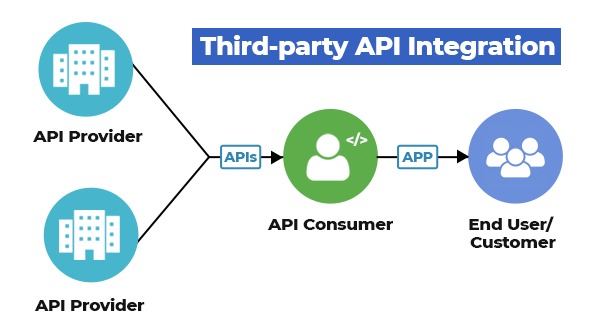
A third-party API integration adds external data to the internally developed app to enhance its features. The best example of a third-party API, commonly integrated, are the payment gateways. Imagine the time that would be required to build this code from scratch when an external component is already available?
Why do third-party APIs have such importance in the application programming world? Picture this, when you go to a restaurant, you choose from the menu and give your order to the waiter, he or she takes your order to the kitchen where the chef prepares your order and brings back your appetizing meal. In this scenario, the waiter is the third-party API whose only job is to communicate requests to an external system that will deliver a finished result back to your app. There is hardly any effort from your side in this whole transaction. – except of course a cost outlay.
API integration with third-party solutions is one of the most efficient methods for online businesses to provide new services in the shortest possible time.
How do Third Party API Integrations work?
In a nutshell, API describes how one computer program interacts with another. Classes, procedures, functions, structures, and constants are all part of it.
A third-party API is located on a server that belongs to a third-party service. Developers can access its features by linking to a JavaScript library or by making an HTTP request to a specified URL pattern. When the connection is made, the user’s request will be sent from the app to a server through the API and back. – it is a two-way path.

Different types of APIs
There are public APIs that can be used by any developer, such as social media bots but there are more types of APIs, based in how they function.
1. Public or Free APIs
A public API or open API is free to access by any outside business or developer. Public APIs usually have an easier authentication and authorization process. The most common open APIs are those provided by Google to access its many products like AdSense, Google Maps and AMP. WordPress also has numerous categories of open APIs to expand WordPress capabilities. The Telegram API is a free messaging service that also allows businesses to build their own version with full customization of the design.
The best APIs, even free ones, must have good API documentation that is constantly updated. Always go through the API documentation before integrating an API. Security in public APIs is maintained by providing a free key to those integrating their APIs so that your calls to the API from your own App are not intercepted by unauthorized actors.
2. Partner APIs
These APIs facilitate business-to-business processes and are only available to authorized subscribers. For example, if your app wants to connect to an external CRM provided by a vendor, then an API will be provided by the vendor to connect internal data systems with external parties. Businesses that use HubSpot marketing CRM for example, use partner APIs. Partner APIs usually have a license agreement and have higher authentication, authorization, and security mechanisms in place. Similar is the case with payment gateway APIs.
3. Internal APIs
These are private APIs that are intended for use only within the business enterprise. For example, data sharing between HR and payroll systems. Internal APIs can greatly reduce development time by creating an interface that accesses company’s backend information and then distributing it publicly. News Today and Guardian media use a number of internal APIs to speed up their app development process. So, while internal APIs are not truly be third-party, they are an important API type.
Commonly used third-party integrations for your App
Modern apps, whether business or consumer facing need to use external tools like social-logins, online payments etc. No app can be developed in isolation. While there are numerous third party application interfaces by different providers, these are the ones most commonly used:
Chat: The chat feature is commonly used to coordinate customer service and to provide users with instant online guidance. WhatsApp integration into apps has become increasingly popular, so too are others like Zendesk Support and LiveChat. Third-party integrations have advanced features which would be impossible for businesses to develop from scratch.
Access and Authorization: We discussed social login before. This authorization method is commonly used by many apps for quick user authentication. There are other authorization services available if you’re working on a corporate app where social logins are not used. For example, you might set up a single sign-on for all systems under the corporate domain or utilise an external cloud directory to keep track of all clients.
Polls: Polls are used in a variety of apps to assess the quality of customer service or give feedback on products or services. In corporate apps, you may also vote on workflow-related concerns or collect ideas for a product upgrade. Form.io and Typeform are two popular API integrations.
Payments: Almost every site and app now accepts credit card and wallet payments. All apps use third party APIs that lets you connect to a payment gateway. Payment gateways can also manage refunds, set up recurring charges, change currencies, and so on, in addition to regular payments. PayPal, Braintree, and Stripe are all common connectors.
Geolocation: Geolocation is used by a large variety of services. Banking apps use it to display nearby ATMs and bank branches, food delivery apps help customers to track their delivery, real estate apps plot routes and so on. Clients benefit from built-in geolocation, which improves the user experience. Google Maps API and Google Directions API are popular geolocation integrations.
Related read: Geolocation App Development: Do’s and Don’ts
In conclusion
Before deciding to use third party integrations, always weigh the advantages along with the financial risks. The most important piece of advice we can provide you, as a mobile app development company with 18 yrs in this space, is to question the necessity and logic of a particular integration for your app, and to constantly keep your target audience in mind. After all, the fundamental goal of your online application is to improve the user experience, not to make it more difficult.





